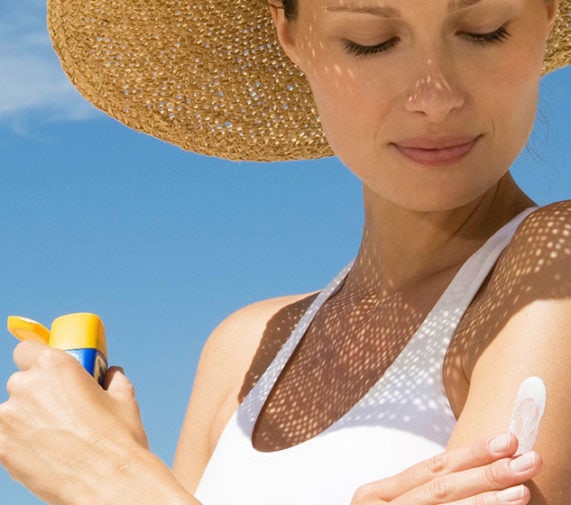As the days grow warmer, it’s a good time to improve your sunscreen habits. A high-quality broad-spectrum sunscreen is your best anti-aging defense and an important part of a healthy lifestyle.
Though nearly all melanomas are tied to UV exposure, nearly all are preventable. It doesn’t have to be a chore anymore, either: Newer products barely resemble the goopy creams from years ago. Today, you can find sun protection that is sheer and silky, soothing and packed with natural compounds that enhance your skin.
When choosing a sunscreen, skip the bargains. In a JAMA Dermatology study, a whopping 40% of the top 65 brands on Amazon—those with the greatest number of reviews and a four-out-of-five rating—did not meet basic protection guidelines from the American Academy of Dermatology (AAD). AAD only recommends sunscreens that are water-resistant, with broad-spectrum coverage (blocking both UVA and UVB light) and a minimum SPF of 30, which protects you from 97% of harmful rays.
A few tips to boost your personal SPF rating in the days ahead:
Kon-Mari the old stuff. Expired or otherwise ineffective sunscreen won’t “bring you joy” if it leads to one of those weird patchy sunburns. Hint: take a Sharpie and write the date on newly purchased bottles so you know you are using fresh products.
Seek the strongest protection. If your skin is sensitive or you’ve had skin procedures such as laser or peels, you need top-tier protection such as ZO Broad Spectrum SPF 50, a mild, non-irritating formulation that is thicker than most sunscreens and helps restore your skin’s hydration.
Baby your sunscreen. At the beach? Put your sunscreen in your cooler. Keep travel-sized products in your handbag or briefcase, but not in your car, where heat rapidly breaks down protective compounds. One good portable option: ZO Sunscreen with primer, a sheer, quick-drying sunscreen with universal tint and natural melanin, which shields skin from high-energy visible (HEV) light. This lotion has a silky matte finish that minimizes the look of fine lines.
Think “golf ball.” That’s roughly the amount of lotion you need to cover your body. According to the AAD, most Americans use only 25% to 50% of what’s needed for full protection. If you prefer a spray, it’s best to spray into your palm, then rub into skin for full coverage. Or choose ZO Oclipse Sun Spray, developed by Dr. Zein Obagi with a unique 12-hour time-release formula and soothing anti-irritant properties for use on both face and body. This all-angle spray is recommended by the Skin Cancer Foundation and provides better coverage than other sprays.
Use sunscreen daily. If you tend to forget, keep your sunscreen in the bathroom and apply after showering. Even during winter or on cloudy days, damaging rays can still age your skin prematurely. Recent studies have shown UV damage also occurs under fluorescent lighting, which emits radiation. Even airplanes aren’t always safe for your skin. A recent study published in the JAMA Dermatology found that, for airline pilots, one hour of exposure at 30,000 feet is roughly equivalent to the same amount of radiation as a 20-minute tanning-bed session. Passengers sitting in window seats get a smaller dose, of course, but on long flights, your exposure to UV rays can add up.
Don’t rely on cosmetics. Most foundations, powders, and creams don’t offer protection from both UVA and UVB rays. For full protection, apply a strong sunscreen underneath makeup, or substitute tinted sunscreen for foundation. Tinted formulas cover skin imperfections beautifully, and newer shades match a wide range of skin tones. Alastin HydroTint Pro Mineral Broad Spectrum Sunscreen SPF 36 has a universal tint and a slight mineral-based shimmer for a healthy glow. HydroTint has environmentally safe ingredients such as titanium dioxide and zinc oxide, making it perfect for use near sensitive ocean reefs.
Use a phone app. Ultraviolet (free, IOS) gives you a quick map-based reading that advises how much protection you’ll need outside, while UVAlert (free, IOS and Android) provides an hour-by-hour forecast of the day’s UV index rating, from 0 to 11 (extreme risk). Whatever the rating, make sure to apply sunscreen at least 30 minutes before going outdoors, then reapply every two hours. For surfing, swimming and winter sports, it’s best to use a thicker lotion and reapply more frequently. One top choice: Alastin Broad Spectrum SPF 30+ Sunscreen, with superior water resistance up to 80 minutes, plus hydration and soothing phytonutrients to help you heal after skin treatments—or too much sun. Another good choice: ZO Smart Tone, with a sheer matte finish, anti-oxidants, plant stem cell components and anti-redness ingredients that promote the repair of damaged skin.
When you take a few minutes to invest in your personal sunscreen best each day, the results will last a lifetime.
twistup
Love OrangeTwist? Join our twistup membership and receive a $100 gift card today!



